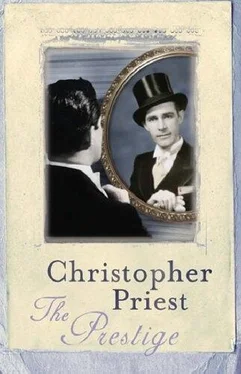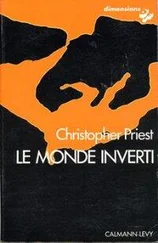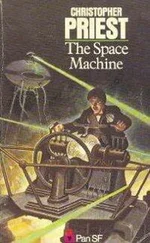Christopher Priest - The Prestige
Здесь есть возможность читать онлайн «Christopher Priest - The Prestige» весь текст электронной книги совершенно бесплатно (целиком полную версию без сокращений). В некоторых случаях можно слушать аудио, скачать через торрент в формате fb2 и присутствует краткое содержание. Жанр: Современная проза, на английском языке. Описание произведения, (предисловие) а так же отзывы посетителей доступны на портале библиотеки ЛибКат.
- Название:The Prestige
- Автор:
- Жанр:
- Год:неизвестен
- ISBN:нет данных
- Рейтинг книги:2.5 / 5. Голосов: 2
-
Избранное:Добавить в избранное
- Отзывы:
-
Ваша оценка:
- 60
- 1
- 2
- 3
- 4
- 5
The Prestige: краткое содержание, описание и аннотация
Предлагаем к чтению аннотацию, описание, краткое содержание или предисловие (зависит от того, что написал сам автор книги «The Prestige»). Если вы не нашли необходимую информацию о книге — напишите в комментариях, мы постараемся отыскать её.
After ten years of quietude, author Christopher Priest (nominated one of the Best of Young British Novelists in 1983) returns with a triumphant tale of dueling prestidigitators and impossible acts.
In 1878, two young stage magicians clash in a darkened salon during the course of a fraudulent sйance. From this moment, their lives spin webs of deceit and exposure as they feud to outwit each other. Their rivalry takes them both to the peak of their careers, but with terrible consequences. It is not enough that blood will be spilt — their legacy is one that will pass on for generations.
The Prestige
The Prestige
The Prestige — читать онлайн бесплатно полную книгу (весь текст) целиком
Ниже представлен текст книги, разбитый по страницам. Система сохранения места последней прочитанной страницы, позволяет с удобством читать онлайн бесплатно книгу «The Prestige», без необходимости каждый раз заново искать на чём Вы остановились. Поставьте закладку, и сможете в любой момент перейти на страницу, на которой закончили чтение.
Интервал:
Закладка:
I heard a sudden and violent crackling sound, and from within the building there came a series of brilliant and horrific flashes: white, blue-white, pink-white, repeated erratically but rapidly. So fierce were these explosions of light that they glared not only at the one or two windows in my sight, but revealed the tiny cracks and apertures in the fabric of the walls.
I confess that at this moment my resolve briefly failed, and I even glanced back to see if Randy and his carriage were still within hailing distance. (No sign of him!) My faint heart became even fainter when, within two or three more steps, I came upon a hand-painted sign mounted on the wall beside the main door. It said:
GREAT DANGER
Keep Out!
As I read this the electric discharges from within died away as abruptly as they had started, and it seemed a positive omen. I banged my fist on the door.
After a wait of a few moments, Nikola Tesla himself opened the door. His expression was the abstracted one of a busy man who has been irritatingly interrupted. It was not a good start, but I made the best of it.
"Mr Tesla?" I said. "My name is Rupert Angier. I wonder if you recall our correspondence? I have been writing to you from England."
"I know nobody in England!" He was staring behind me, as if wondering how many more Englishmen I had brought with me. "Say your name again, good sir?"
"My name is Rupert Angier. I was present at your demonstration in London, and was greatly interested—"
"You are the magician! The one Mr Alley knows all about?"
"I am the magician," I confirmed, although the meaning of his second query was for the moment lost on me.
"You may enter!"
So many impressions about him at once, of course reinforced by my having spent several hours with him after our first exchange. At the time I noticed his face first. It was gaunt, intelligent and handsome, with strong Slavic cheekbones. He wore a thin moustache, and his lanky hair was parted in the middle. His appearance was in general untended, that of a man who worked long hours and slept only when there was no alternative to exhaustion.
Tesla is equipped with an extraordinary mind. Once I had made my identity clear to him he remembered not only what we had corresponded briefly about, but that I had written to him earlier, some eight years ago, asking for a copy of his notes.
Inside the laboratory he introduced me to his assistant, a Mr Alley. This interesting man appears to fulfil many roles in Tesla's life, from scientific assistant and collaborator, to domestic servant and companion. Mr Alley declared himself to be an admirer of my work! He had been in the audience during my show in Kansas City in 1893, and spoke briefly but knowledgeably about magic.
By all appearances the two men work in the laboratory alone, with only the astonishing research equipment for company. I ascribe this near-human quality to the apparatus because Tesla himself has a habit of referring to his equipment as if it had thoughts and instincts. Once, yesterday, I heard him say to Alley, "It knows there's a storm coming"; at another moment he said, "I think it's waiting for us to start again."
Tesla seemed relaxed in my company, and the brief hostility I had experienced at the door was nowhere evident during the rest of my time with him. He declared that he and Alley had been soon to break for luncheon, and the three of us sat down to simple but nourishing food that Alley quickly produced from one of the side rooms. Tesla sat apart from us, and I noticed he was a finicky eater, holding up each morsel for close inspection before putting it in his mouth, and discarding as many of them as he consumed. He wiped his hands and dabbed his lips on a small cloth after each mouthful. Before he rejoined us, he swept away his uneaten food into a bin outside the building, then scrupulously washed and wiped dry his utensils before placing them inside a drawer, which he locked.
Rejoining Alley and myself, Tesla interrogated me about the use of electricity in Britain, how widespread it was becoming, what was the British government's commitment to long-term generation and transmission of power, the kinds of transmission being envisioned and the uses to which it was being put. Fortunately, because I had planned to have this meeting with Tesla, I had done my homework on the subject before leaving England, and was able to converse with him on a reasonably informed level, a fact for which he seemed appreciative. He was especially gratified to learn that many British installations appeared to favour his polyphase system, which was not the case here in the USA. "Most cities still prefer the Edison system," he growled, and went into a technical exposition of the failings of his rival's methods. I sensed that he had rehearsed these sentiments many times in the past, and to listeners better equipped to take them in than I was. The upshot of his complaint was that in the end people would come around to his alternating current system, but that they were wasting a lot of time and opportunities while they did so. On this subject, and on several others related to his work, he sounded humourless and forbidding, but at other times I found him delightful and amusing company.
Eventually, the focus of his questions turned to myself, my career, my interest in electricity, and to what uses I might wish to put it.
I had resolved, before leaving England, that were Tesla to enquire into the secrets of my illusions he would be one person to whom I would make an exception and reveal anything in which he might show interest. It seemed only right. When I had seen his lecture in London he had had all the appearance of a member of my own profession, taking the same delight in surprising and mystifying the audience, yet, unlike a magician, being more than willing, anxious even, to reveal and share his secrets.
He turned out to be incurious, though. I sensed that nothing would be gained by my harking on the subject. Instead, I let him direct our conversation, and for an hour or two he rambled entertainingly over his conflicts with Edison, his struggles against bureaucracy and the scientific establishment, and most of all his successes. His present laboratory had been funded, in effect, by the work of the last few years. He had installed the first water-powered city-sized electricity generator in the world; the generating station was at Niagara Falls, and the beneficiary city was Buffalo. It is true to say that Tesla had made his fortune at Niagara, but like many men of sudden wealth he wondered how long he could make last what he had.
As gently as I could I kept the conversation centred on money, because this is one of the few subjects where our interests genuinely meet. Of course he would not impart details of his finances to me, a virtual stranger, but funding is clearly a preoccupation. He mentioned J. Pierpoint Morgan, his present sponsor, several times.
Nothing was discussed between us that touched directly on the reason for my visit here, but there will be plenty of time for that in the days ahead. Yesterday, we were just getting to know one another, and learning of each other's interests.
I have said little of the dominant feature of his laboratory. All through the meal, and during the long conversation that followed, we were overshadowed by the bulk of his Experimental Coil. Indeed, the entire laboratory can be said to be the Coil, for there is little else there apart from recording and calibrating apparatus.
The Coil is immense. Tesla said that it had a diameter in excess of fifty feet, which I can well believe. Because the interior of the laboratory is not brightly lit the Coil has a gloomy, mysterious presence, at least while it is not being used. Constructed around a central core (the base of the tall metal pole that I had seen protruding through the roof), the Coil is wound around numerous wooden and metal battens, in a complexity that increases the closer in to the core you explore. With my layman's eyes I could make no sense of its design. The effect was to a large extent that of a bizarre cage. Everything about it and around it seemed haphazard. For instance, there were several ordinary wooden chairs in the laboratory, and several of these were in the immediate vicinity of the Coil. As indeed were many other bits and pieces: papers, tools, scraps of dropped and forgotten food, even a grubby-looking kerchief. I duly marvelled at the Coil when Tesla conducted me around it, but it was impossible for me then to understand any of it. All I grasped was that it was capable of using or transforming huge amounts of electricity. The power for it is sent up the mountain from Colorado Springs below; Tesla has paid for this by installing the town generators himself!
Читать дальшеИнтервал:
Закладка:
Похожие книги на «The Prestige»
Представляем Вашему вниманию похожие книги на «The Prestige» списком для выбора. Мы отобрали схожую по названию и смыслу литературу в надежде предоставить читателям больше вариантов отыскать новые, интересные, ещё непрочитанные произведения.
Обсуждение, отзывы о книге «The Prestige» и просто собственные мнения читателей. Оставьте ваши комментарии, напишите, что Вы думаете о произведении, его смысле или главных героях. Укажите что конкретно понравилось, а что нет, и почему Вы так считаете.











